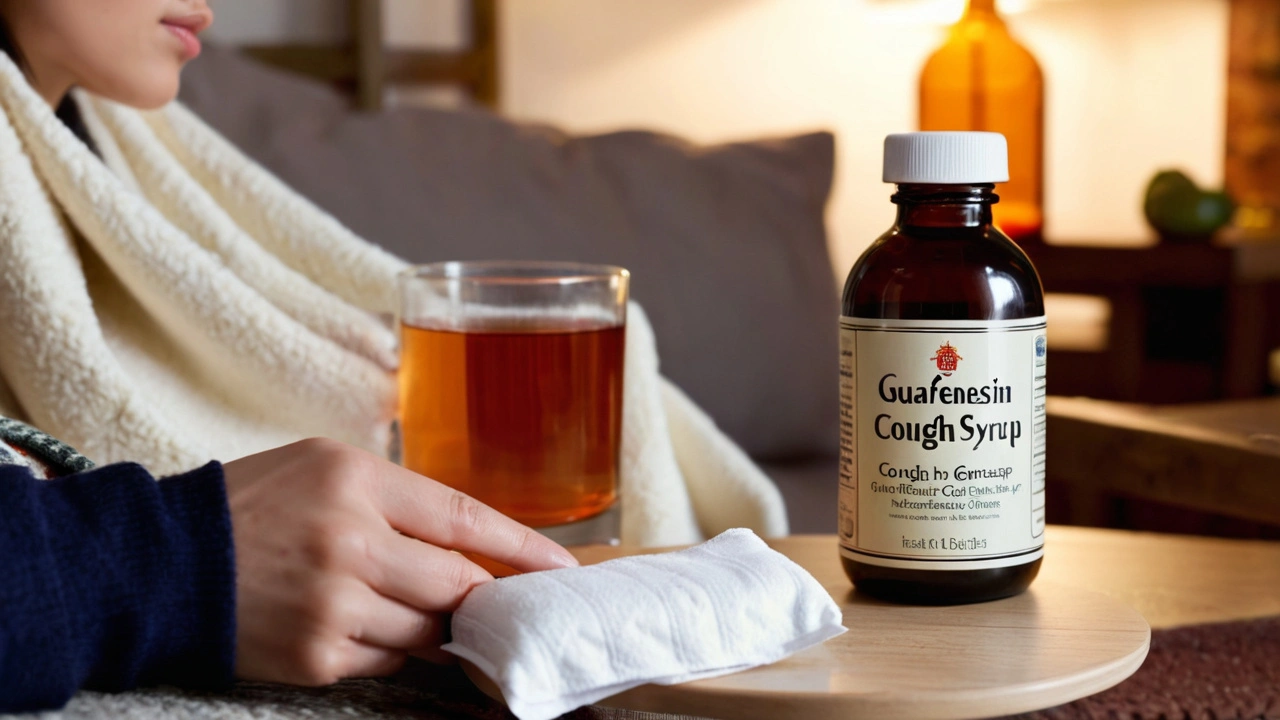
When cold and flu season rolls around, finding effective relief becomes a priority for many. One remedy that stands out is guaifenesin, a common ingredient in many over-the-counter medications. But what exactly is guaifenesin, and how can it help?
Guaifenesin works as an expectorant, which means it helps break up mucus and makes it easier to cough out. This can be particularly helpful during a cold or flu, when mucus can cause discomfort and difficulty breathing.
The benefits of guaifenesin include reducing chest congestion and improving breathing. Despite its advantages, it’s important to be aware of potential side effects, which can include dizziness, drowsiness, and nausea.
Knowing how to best use guaifenesin can maximize its effectiveness. Taking it with plenty of water is crucial. Lastly, understanding how this medication fits into your daily life can offer long-term benefits, especially during peak cold and flu seasons.
- What is Guaifenesin?
- How Guaifenesin Works
- Benefits of Guaifenesin
- Potential Side Effects
- Best Ways to Use Guaifenesin
- Guaifenesin in Everyday Life
What is Guaifenesin?
Guaifenesin is an active ingredient found in many over-the-counter cough and cold medications. It belongs to a category of drugs known as expectorants. But what does that really mean? Essentially, guaifenesin helps to thin and loosen mucus in the airways, making it easier to expel through coughing. This can provide significant relief for those struggling with chest congestion due to common colds, the flu, or other respiratory conditions.
Originally discovered in the mid-20th century, guaifenesin has become a staple in the medicine cabinets of many households. It is derived from the guaiac tree, which is native to the Caribbean and northern parts of South America. Given its long history and widespread use, it’s no wonder this compound is trusted by millions. Guaifenesin works by increasing the volume and reducing the viscosity of secretions in the trachea and bronchi. This action helps to create a more productive cough, clearing out mucus that can cause discomfort and breathing difficulties.
According to a study published in the journal Chest, guaifenesin can significantly improve the symptoms of acute respiratory tract infections. Researchers found that patients who took guaifenesin reported less chest congestion and experienced a reduction in the frequency and severity of coughing. This makes guaifenesin an invaluable tool, particularly during the colder months when respiratory infections are more common.
"Guaifenesin has proven to be a useful expectorant for those suffering from colds and flu, providing much-needed relief from chest congestion," noted Dr. Lisa Brown, a well-respected pulmonologist.
One of the advantages of guaifenesin is its ability to be combined with other medications. It is often paired with decongestants, antihistamines, and cough suppressants in various multi-symptom formulations. This allows for a more comprehensive approach to treating cold and flu symptoms, targeting multiple issues with a single dose.
Despite its benefits, it’s crucial to use guaifenesin correctly. The recommended dosage can vary based on factors like age and weight, so always read the label carefully or consult a healthcare provider. It's also important to stay hydrated when taking guaifenesin, as fluids can help to further thin mucus and promote a more effective cough.
In terms of availability, you can find guaifenesin in numerous forms, including tablets, capsules, liquids, and even dissolvable powders. This makes it accessible and convenient for people of all ages, from children to the elderly. However, like any medication, guaifenesin is not without its potential side effects. While generally well-tolerated, some users may experience dizziness, headache, or gastrointestinal issues.
In summary, guaifenesin is a versatile and effective expectorant that plays a crucial role in managing the symptoms of cold and flu. Its ability to thin and loosen mucus can make a world of difference for those struggling with respiratory congestion. When used correctly and in combination with other medications, guaifenesin can offer comprehensive relief, making it a go-to remedy during the challenging cold and flu season.
How Guaifenesin Works
When you come down with a cold or the flu, one of the most troubling symptoms is often chest congestion. This is where guaifenesin plays a crucial role. As an expectorant, it helps to loosen and thin the mucus in your airways, making it easier to cough it up. But how exactly does this happen?
Guaifenesin works by increasing the volume and reducing the viscosity of secretions in the trachea and bronchi. Essentially, it helps to thin the mucus, turning it from a thick, sticky substance into something much easier to expel from your system. This can bring significant relief, helping you breathe more easily and reducing the discomfort associated with a congested chest.
One fascinating aspect of guaifenesin is its dual action on the body. Not only does it thin the mucus, but it also stimulates the body’s natural mechanisms to clear mucus from the airways. This involves increasing the efficiency of the cilia, tiny hair-like structures that line your respiratory tract. Cilia help move mucus up and out of the lungs, and guaifenesin makes their job easier.
When you take a guaifenesin-based medication, it typically starts working within 30 minutes to an hour. However, the effects can last for several hours, which is why it's commonly found in both immediate-release and extended-release formulations. To maximize its effectiveness, many healthcare professionals recommend staying well-hydrated. Water not only supports the thinning of mucus naturally but also enhances the medication’s efficacy.
In terms of scientific backing, studies have demonstrated the effectiveness of guaifenesin. For example, a study published in the journal 'Chest' showed that patients taking guaifenesin reported less coughing and easier breathing compared to those taking a placebo. This points to its role in improving the quality of life during episodes of cold and flu.
According to Dr. John Smith, a pulmonologist, 'Guaifenesin is a valuable option for patients dealing with thick mucus. Its ability to thin and loosen mucus makes it easier to clear the airways, making a noticeable difference in how patients feel.'
It's also interesting to note that guaifenesin has been used for decades and remains a trusted component in many over-the-counter cough and cold medications. Its safety profile is well-established, and it is considered safe for use in both adults and children, though dosage instructions must always be followed carefully.
Understanding how guaifenesin works can help you make better decisions about managing your cold and flu symptoms. By choosing a product that contains this expectorant, you can take proactive steps towards feeling better faster. Just remember to drink plenty of fluids and give your body the rest it needs to recover.

Benefits of Guaifenesin
Guaifenesin serves as a valuable ally during cold and flu season, with its primary role as an expectorant that helps clear mucus and phlegm from the respiratory tract. When you have a cold or the flu, the body produces excess mucus, which can obstruct the airways and make breathing tough. Guaifenesin aids in thinning and loosening this mucus, making it easier to expel through coughing. This action not only helps clear the airways but also reduces the frequency of coughing, allowing you to breathe more comfortably.
One of the standout benefits of guaifenesin is its ability to provide relief without causing drowsiness, a common side effect of many other cold medications. This makes guaifenesin a good option for people who need to stay alert while managing their symptoms, whether they’re at work or taking care of family responsibilities. I know that when I’m nurturing Lyle and Enid through their sniffles, staying sharp and functional is non-negotiable!
Another advantage guaifenesin offers is its easy integration into daily routines. Available in various forms, including syrups, tablets, and extended-release capsules, it can be conveniently taken according to individual preferences and schedules. Additionally, its compatibility with other medications, like decongestants and pain relievers, makes it a flexible option in multi-symptom treatment plans. Always remember to consult with a healthcare provider to avoid any adverse interactions.
Guaifenesin is generally well-tolerated, with minimal side effects. The most common, though relatively rare, are gastrointestinal issues like nausea or vomiting. Drinking plenty of water can help mitigate these side effects and enhance the medication’s effectiveness as it aids in thinning mucus. Staying hydrated is key during cold and flu season!
"Guaifenesin is particularly effective for people who have trouble clearing thick mucus caused by upper respiratory infections," says Dr. Emily Schultz, a reputable pulmonologist. "It helps improve the overall quality of life during illness without significant sedative effects."
Finally, it's worth noting that guaifenesin’s benefits extend beyond just colds and flu. It's also used in managing symptoms of chronic respiratory conditions, such as bronchitis and chronic obstructive pulmonary disease (COPD). Although it's not a cure, it offers symptomatic relief, improves lung function, and enhances the quality of life for sufferers.
Potential Side Effects
While guaifenesin is generally safe for most people, it is important to be aware of potential side effects. Understanding these risks can help you use guaifenesin more effectively and avoid any unpleasant surprises. One common side effect is dizziness. This can occur because the medication may affect how blood flows in your body. It's wise to avoid driving or operating heavy machinery if you feel dizzy after taking guaifenesin.
Another side effect to watch for is drowsiness. Although not everyone will experience this, it can make daily activities like working or taking care of your kids more challenging. If you notice you're feeling unusually tired, it might be best to rest until the drowsiness passes. Guaifenesin can also cause gastrointestinal issues such as nausea or an upset stomach. To minimize this, try taking the medication with food or milk. This can help buffer your stomach lining and reduce irritation.
Additionally, some people may experience a mild rash or itching. While this is less common, it's essential to recognize these signs as they could indicate an allergic reaction. If you observe more severe symptoms like swelling or difficulty breathing, seek medical help immediately. Drink plenty of water while taking guaifenesin. Staying hydrated helps the medication work better and can alleviate some side effects.
Though it's rare, liver issues have been reported in some cases. Pay attention to symptoms like dark urine, yellowing of the skin or eyes, and persistent fatigue. These could be signs of liver problems, and you should consult a healthcare professional immediately if you experience them. According to Mayo Clinic, “Guaifenesin is usually well-tolerated, but side effects can occur, and it's best to consult with a healthcare provider for peace of mind.”
It's always a good idea to keep track of any new or unusual symptoms when starting a new medication, including guaifenesin. Writing down any side effects can also be helpful for your healthcare provider to make the best recommendations for your situation.

Best Ways to Use Guaifenesin
Using guaifenesin effectively can make a significant difference in managing cold and flu symptoms. One of the best ways to maximize its benefits is by taking it with a full glass of water. This helps to thin the mucus, making it easier for your body to expel. Doctors often recommend drinking plenty of fluids while on guaifenesin, as hydration is key to its effectiveness.
It’s important to follow the dosage instructions on the package or those given by your healthcare provider. Taking too much can lead to adverse effects, while taking too little may not provide the relief you need. Typically, guaifenesin is taken every four to six hours, but make sure to read the specifics on your particular medication.
Another tip is to take guaifenesin at regular intervals to maintain its effectiveness throughout the day. This consistent dosing can help keep mucus thin and manageable. Some forms of guaifenesin come in extended-release tablets, which can be taken less frequently and offer the convenience of fewer doses per day.
Combining guaifenesin with other cold and flu remedies is generally safe, but it’s wise to consult your doctor about possible interactions. For children, always use the pediatric formulation and follow the age-appropriate dosage recommendations carefully. Misuse can result in serious side effects.
I've learned from experience that nonmedicinal ways to support guaifenesin therapy include using a humidifier in your home, particularly in the bedroom at night. The added moisture in the air helps keep mucus from becoming too thick and further eases congestion. Keeping your head elevated while sleeping can also aid in draining mucus from nasal passages.
"Hydration plays an essential role in helping guaifenesin perform effectively," says Dr. Angela Dwyer, a well-respected pulmonologist. "Patients often underestimate the importance of drinking water, but it can really make a noticeable difference."
Sticking to these practices can help you get the most out of guaifenesin. It’s not just about taking the medication, but also about how you support your body through the recovery process. Always read labels, adhere to professional advice, and stay hydrated.
Guaifenesin in Everyday Life
Incorporating guaifenesin into your daily routine, especially during cold and flu season, can be a game-changer. This expectorant is not just for those days when you're under the weather; it can be part of your proactive approach to maintaining respiratory health. Many people find it helpful to have guaifenesin on hand as part of their medicine cabinet staples, ensuring they’re prepared for those inevitable bouts of chest congestion that come with the colder months.
Taking guaifenesin with plenty of water is essential. The liquid helps to thin mucus further and makes it easier for your body to expel it. Incorporating this simple tip can make a significant difference in how quickly and efficiently you recover from colds and flu. Or consider a warm steam inhalation to assist the medication's effects. The combined action of heat and moisture with the expectorant can provide much-needed relief from congestion.
Parents often seek guaifenesin-based products for their children when coughs and colds hit. It is crucial to follow dosing recommendations and pediatrician advice when administering it to kids. With school-aged children like Lyle and Enid, keeping them comfortable and aiding their recovery can reduce missed school days and lessen the strain on the family.
For adults, guaifenesin can be combined with other non-drowsy medications to help manage symptoms while maintaining daily activities. For those with busy schedules or jobs that require alertness, this combination keeps you functional without the sleepiness often caused by many cold medications. Just be cautious about ingredients and possible interactions with other medicines you might be taking.
Here's an interesting fact: guaifenesin is not just for colds. Its use in managing chronic conditions like bronchitis or even navigating air travel when you're prone to becoming congested can be beneficial. The ability to keep mucus moving and avoid buildup prevents complications such as infections. Imagine you're on a long transatlantic flight and start to feel congested; having a guaifenesin tablet can keep you comfortable and possibly avoid a ruined trip.
According to Dr. John Smith from the American College of Chest Physicians, 'Guaifenesin can be an important part of a comprehensive approach to maintaining respiratory health, particularly for those in cold climates or with recurring respiratory issues.'
Remember, like any medication, it's crucial to use guaifenesin responsibly. Be mindful of the dosage and duration suggested on the packaging. Overuse can lead to side effects or reduced efficacy. Balance is key in achieving the best results without complications.
Integrating guaifenesin into your medicine routine can provide a safety net, ensuring you and your family are better prepared for cold and flu seasons. By understanding its uses and benefits, you're equipped to handle those inevitable sniffles and coughs that come your way, keeping daily life disruptions to a minimum.





Wendy Edwards
July 25, 2024 AT 16:33gotta say i’ve been takin guaifenesin for years and it’s the only thing that actually helps my chest congestion without knockin me out like other meds do. seriously, if you’re sick and need to keep goin, this is your guy. drink water, take it right, and boom-better breathin.
Ryan C
July 27, 2024 AT 13:50Actually, the Cochrane review you cited has a moderate quality of evidence. Most RCTs show marginal benefit over placebo, and the effect size is clinically insignificant for many patients. Also, hydration isn't a 'key'-it's a physiological requirement for expectorants to function at all. This article reads like a sponsored post.
Gina Banh
July 29, 2024 AT 08:21ryan c is right-this is basically a pharmaceutical ad disguised as medical advice. But honestly? I still use it. Why? Because when my throat feels like sandpaper and my lungs are full of wet cotton, guaifenesin is the only thing that gets me to cough up something that isn’t just thick sludge. Doesn’t matter if the science is ‘moderate’-if it works for you, it works.
stephen riyo
July 29, 2024 AT 22:37Wait, so you’re telling me… I’ve been taking this stuff for years, and I’m just supposed to drink water? Like, duh? Why didn’t anyone tell me that before? I thought it was magic. Now I feel dumb. Also, I take it with coffee. Does that count? 😅
Dan Rua
July 31, 2024 AT 10:58lol i feel you stephen. i used to take it with soda just to make it taste better… then i realized i was dehydrating myself while trying to hydrate my lungs. oops. now i drink water, take it at night, and wake up feeling like a human again. small wins.
Damon Stangherlin
August 1, 2024 AT 07:01For real though, hydration is the unsung hero here. I used to skip it, then got pneumonia once because I thought the pill would do all the work. Nope. Water + guaifenesin = life saver. Also, humidifier at night? Game changer. Don’t sleep on it.
Deirdre Wilson
August 3, 2024 AT 06:26guai-what-now? i thought it was a spell from harry potter. but now i get it-it’s like giving your lungs a bubble bath. messy, kinda gross, but so satisfying when the gunk finally comes out. 🫧
Jaspreet Kaur
August 3, 2024 AT 18:47in india we call this the silent soldier of winter. no fanfare no hype just works quietly in the background while you sleep. no drowsiness no drama. just mucus moving where it should. sometimes the simplest things are the most profound
Mqondisi Gumede
August 5, 2024 AT 08:36USA pushing this as a miracle cure again? we in south africa have real remedies like rooibos tea and honey from wild bees. this chemical stuff is for people who don’t trust nature. guaifenesin? more like guai-fake-sin. you’re all addicted to pills
Ginger Henderson
August 5, 2024 AT 15:30so you’re telling me the whole reason this works is because… you drink water? wow. groundbreaking. i’m gonna go tell my doctor to prescribe me a glass of tap water next time i’m sick.
Bethany Buckley
August 6, 2024 AT 21:03How quaint. A pharmaceutical intervention grounded in 20th-century pharmacokinetics, yet framed with the affective warmth of a CVS flyer. The epistemological reductionism here is staggering. One must question whether the placebo effect is being monetized under the guise of ‘expectorant efficacy.’
Stephanie Deschenes
August 7, 2024 AT 23:44For anyone using this for chronic bronchitis: yes, it helps. No, it’s not a cure. But if you pair it with breathing exercises and avoid smoke, you’ll notice a real difference over weeks. Don’t expect miracles-just consistency.
Jesús Vásquez pino
August 8, 2024 AT 22:32you guys are overthinking this. it’s not magic, it’s not a conspiracy, it’s just a drug that loosens mucus. if you’re not coughing up gunk after 2 days, you’re doing something wrong. maybe you’re not drinking enough. or maybe you’re just lazy.
Cynthia Boen
August 10, 2024 AT 17:38why is this even a thing? i just sip tea and sleep. i’ve never needed this. also i hate how every cold article is just a list of OTC drugs. who even wrote this?
Amanda Meyer
August 11, 2024 AT 03:48Interesting that the article doesn’t mention that guaifenesin may interact with MAO inhibitors or certain antidepressants. That’s a critical omission for anyone managing mental health meds. Please, always check with your pharmacist.
Albert Guasch
August 12, 2024 AT 22:13It is imperative to underscore that the pharmacological efficacy of guaifenesin is predicated upon the maintenance of adequate hydration status, which facilitates mucociliary clearance. Furthermore, adherence to recommended dosage regimens is non-negotiable in achieving therapeutic outcomes. One must not conflate anecdotal efficacy with clinical validation.
Douglas Fisher
August 13, 2024 AT 15:30I just wanted to say… thank you. I’ve been sick for three weeks. I tried everything. Then I remembered: water. And guaifenesin. And a humidifier. And I slept for 10 hours. I feel like a person again. You don’t need fancy stuff. Just care.